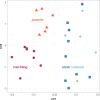Ontogenetic variation in the crocodylian vestibular system
- PMID: 34841534
- PMCID: PMC9005688
- DOI: 10.1111/joa.13601
Ontogenetic variation in the crocodylian vestibular system
Abstract
Crocodylians today live in tropical to subtropical environments, occupying mostly shallow waters. Their body size changes drastically during ontogeny, as do their skull dimensions and bite forces, which are associated with changes in prey preferences. Endocranial neurosensory structures have also shown to change ontogenetically, but less is known about the vestibular system of the inner ear. Here we use 30 high-resolution computed tomography (CT) scans and three-dimensional geometric morphometrics to investigate the size and shape changes of crocodylian endosseous labyrinths throughout ontogeny, across four stages (hatchling, juvenile, subadult and adult). We find two major patterns of ontogenetic change. First, the labyrinth increases in size during ontogeny, with negative allometry in relation to skull size. Second, labyrinth shape changes significantly, with hatchlings having shorter semicircular canal radii, with thicker diameters and an overall dorsoventrally shorter labyrinth than those of more mature individuals. We argue that the modification of the labyrinth during crocodylian ontogeny is related to constraints imposed by skull growth, due to fundamental changes in the crocodylian braincase during ontogeny (e.g. verticalisation of the basicranium), rather than changes in locomotion, diet, or other biological functions or behaviours.
Keywords: allometry; crocodylia; morphology; ontogeny; verticalisation; vestibular system.
© 2021 Anatomical Society.
Figures








References
-
- Adams, D. , Collyer, M. & Kaliontzopoulou, A. (2019) Geomorph: software for geometric morphometric analyses. R Package Version 3.1.0.
-
- Britton, A.R. , Whitaker, R.O. & Whitaker, N.I. (2012) Here be a dragon: exceptional size in a saltwater crocodile (Crocodylus porosus) from the Philippines. Herpetological Review, 43, 541–546.
-
- Brochu, C.A. (1996) Closure of neurocentral sutures during crocodilian ontogeny: implications for maturity assessment in fossil archosaurs. Journal of Vertebrate Paleontology, 16, 49–62.
Publication types
MeSH terms
Grants and funding
- IOB-0517257/United States National Science Foundation Grants
- IOS-1050154/United States National Science Foundation Grants
- IOS-1456503/United States National Science Foundation Grants
- RPG-2017-167/Leverhulme Trust Research Project grant
- ANPCyT-PICT 2016-1039/Agencia Nacional de Promoción Científica y Tecnológica
LinkOut - more resources
Full Text Sources

